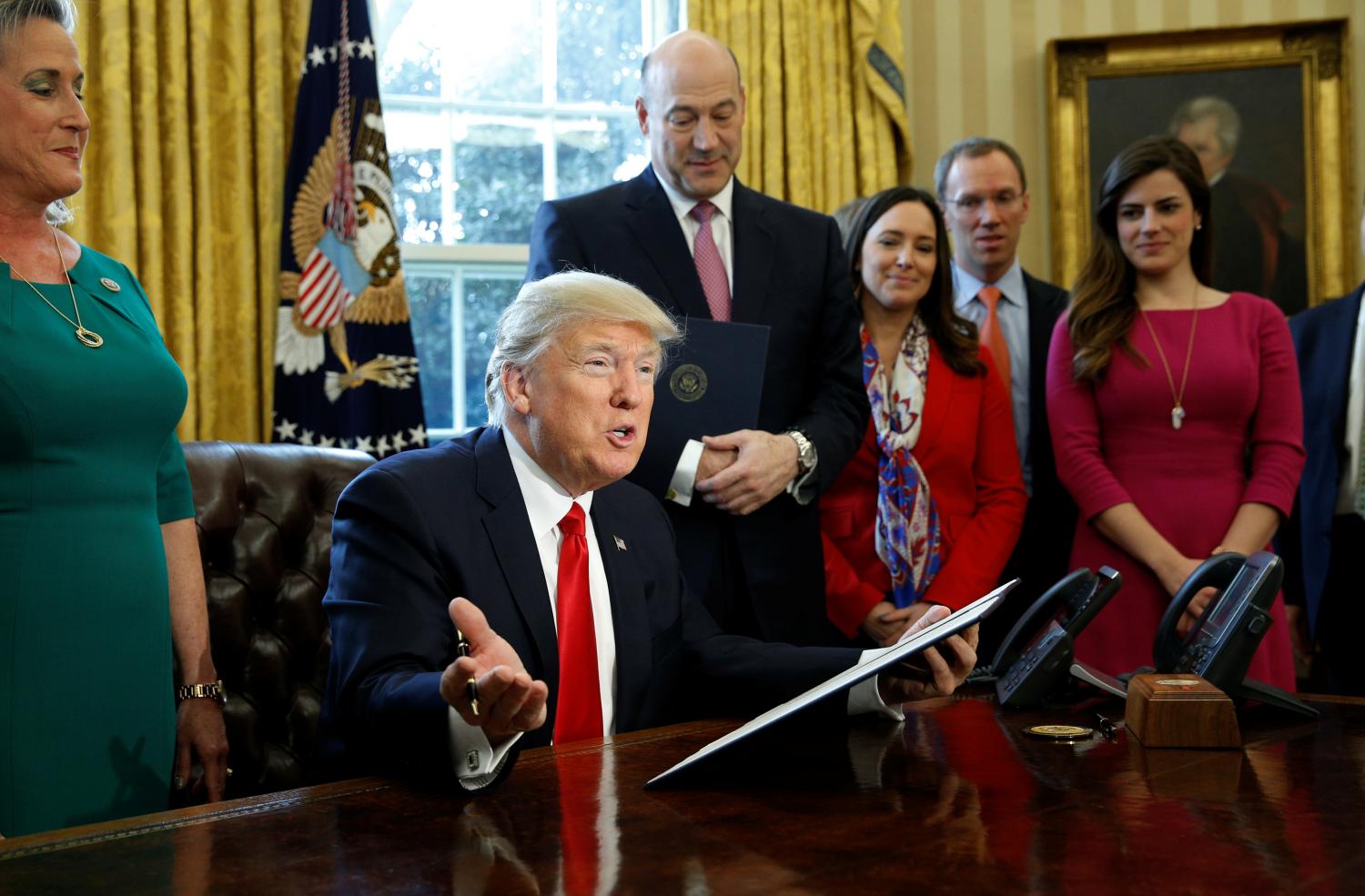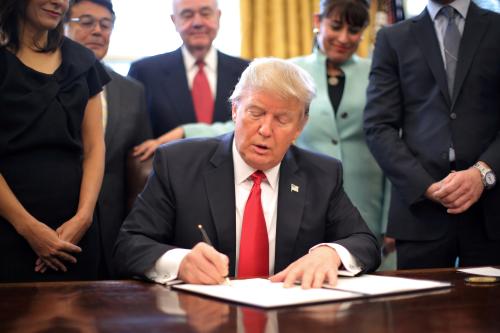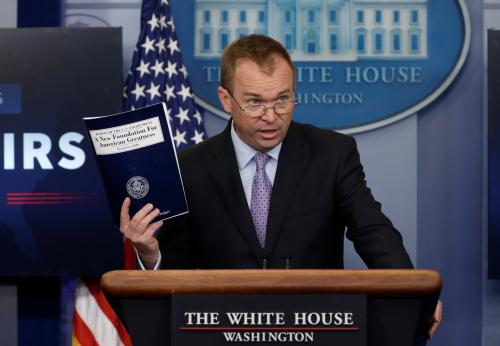This report is part of the Series on Regulatory Process and Perspective and was produced by the Brookings Center on Regulation and Markets. The author did not receive financial support from any firm or person for this article or from any firm or person with a financial or political interest in this article. He is not currently an officer, director, or board member of any organization with a financial or political interest in this article.
Deregulation has been a centerpiece of the Trump Administration’s agenda. One of the key initiatives that the Administration has used to attempt to advance deregulation is a regulatory budget. Modeled on ideas that have percolated in the academic literature for more than a generation, a regulatory budget puts a limit on the costs that agencies such as the Environmental Protection Agency and the Department of Homeland Security can impose on the public through regulation.
Executive Order 13771 outlines the details of the Trump Administration regulatory budget. The Order states, “all agencies are directed that the total incremental cost of all new regulations, including repealed regulations, to be finalized this year shall be no greater than zero, unless otherwise required by law.” The Office of Information and Regulatory Affairs (OIRA) later produced guidance on agency compliance with the regulatory budget and has since worked with agencies to develop annual regulatory budgets.
Regulatory Budgets and Fiscal Budgets
The literature on regulatory budgets has generally been produced by academics and former government officials (largely Republican appointees) hoping to see it used as a tool to constrain agency regulation. One of the primary arguments voiced by those who support a regulatory budget is that it is merely an analogue to a fiscal budget, and so the use of a regulatory budget should be no more controversial than the use of a fiscal budget.
This is superficially compelling, but the analogy has significant limits. When Congress determines the fiscal budget for the government, it takes many factors into account, including the funds available from tax revenue and its own willingness to borrow money to achieve policy goals beyond those allowed by tax revenue. The tax revenue collected by the federal government places a potential budget constraint on the spending of the federal government. Congress might choose to set spending above the level of tax revenue, or (less frequently) underneath it, but it serves as guidepost.
No such guidepost exists in the regulatory world. That is because regulatory costs are very different from fiscal costs. In the case of the fiscal budget, costs are all borne by the federal government as a single entity on behalf of taxpayers, but regulatory costs are borne by a wide variety of actors. Estimates of regulatory costs are plagued by an uncertainty unknown to managers of a fiscal budget. At the conclusion of the fiscal year, we have a pretty fair idea of what was spent by the government; after a year of regulatory costs, we not only don’t know what was spent but we don’t know who did the spending (e.g., firms, consumers, workers).
If we were to have a guidepost for a limit on regulatory costs, what would it be? Two possibilities have been discussed in the literature.
Zero (or Negative) New Regulatory Costs
The Trump Administration has implemented a regulatory budget that allows zero or negative new net costs for regulations. This mirrors many of the academic regulatory budget proposals. A mandate for zero or negative new costs forces agencies to curb new regulations or review and repeal old ones. While there is some flexibility around how to calculate regulatory costs, this essentially prohibits the issuance of costly new regulations unless the agencies remove costly existing regulations. The evidence supports the argument that Executive Order 13771 has played this function, because the Trump Administration has issued very few new regulations.
A zero or negative budget is extremely difficult to adhere to because any administration is likely to be required by statute to issue new regulations or feel political pressure to do so under existing statutes. The Trump Administration is already considering expensive regulations on cigarette warning labels and on food stamp usage. Beyond that, this approach strains the analogy to a fiscal budget. Federal spending has more than doubled over the past twenty years. Indeed, the history of federal spending has been one of consistent increases both in absolute terms and as a percentage of GDP. Federal budget spending, therefore, is not an apt analogy to a regulatory budget with zero or negative net costs.
There is one other problem with analogizing a regulatory budget with zero or negative new costs to a fiscal budget. As noted above, we have no real idea of the magnitude of the current total cost of agency regulations.[1] Unlike with fiscal budgets, there is no hard data on compliance expenditures by regulated parties, nor on the other forms of costs that regulations can impose. There are mostly just forward-looking estimates by federal agencies. And if the government uses a “no incremental costs” approach, how do we handle the question of one-time costs? A fiscal budget would count them only in the year they occur. Many costs imposed by regulations, e.g., requiring the installation of equipment, occur once and then never again. Are those costs “taken off the books (as would be done in a fiscal budget) freeing agencies to impose new costs since the one-time costs are no longer being incurred?
Bounding Regulatory Costs with Regulatory Benefits
When Congress decides the magnitude of federal expenditures, they simultaneously consider the purpose of those expenditures. A regulatory budget focusing on costs would only, by definition, ignore the purpose of regulations – to generate societal benefits. Since 1981, presidents have required that those costs either be exceeded or justified by the benefits produced by regulations. Similarly, government expenditures must be exceeded by tax revenues, or, if deficits are to be tolerated, justified by the Congress’ concurrent decisions on revenues and expenditures. In other words, regulatory policy preceding Executive Order 13771 already adopted the principles of a fiscal budget where benefits serve as the bound on costs.
A regulatory budget, if it set budgetary limits on agencies based on regulatory benefits, would potentially offer new flexibility; it could allow agencies to have regulations with net costs, as long as those net costs were compensated for by benefits from other regulations.[2] An agency like EPA that can produce some regulations with tens of billions of dollars of estimated benefits would have more leeway under a regulatory budget that acts like a fiscal budget. If, instead, a regulatory budget bounded by regulatory benefits were set for the government as a whole, agency flexibility would increase further, with EPA’s benefits being used to justify other agencies’ costly rules.
Christopher DeMuth argues against the use of benefits in a regulatory budget, instead opting for a number chosen by Congress each year. But he acknowledges that, “benefits would indeed be taken into account – but early in the process, when the President and Congress determined the size of each agency’s budget.” He adds, “it is appropriate that regulatory benefits be accounted for by allocating the costs of achieving various goals among the regulatory agencies according to the political judgements of the President and Congress.” Some have argued for exempting regulations with positive net benefits from budget requirements, acknowledging a similar need for benefits to play a role in regulatory budgets.[3]
Is a Regulatory Budget Feasible?
There have been other arguments in favor of a regulatory budget that do not analogize it to a fiscal budget. These are often centered on the failure of rule-by-rule cost-benefit analysis to consider the problem of cumulative regulation. Because cost and benefit numbers are prospective, they (particularly the estimate of benefits) are necessarily speculative, and this gives agencies the flexibility and incentives to make assumptions in their analyses that are potentially incorrect, and to thereby game the rule-by-rule benefit-cost requirement. However, this argument could just as easily be applied to a regulatory budget whether the budget limits are set using benefits or are assumed to be zero.
The Trump Administration has taken the approach of setting budgetary limits at zero or negative new net regulatory costs. Thus, the administration has seemed to rely on the argument that a regulatory budget should spur deregulation rather than the argument that it should be a counterpart to a fiscal budget. As it considers various policy changes, the Trump Administration itself has already begun to show that such a policy is not tenable in the long run unless the Administration is willing to embrace the politically challenging tasks of repealing regulations that have been accepted by regulated parties and whose repeal has no real constituency.[4] More significantly, political reality clearly tells us that a future, pro-regulatory administration will see no usefulness in a budget that permits zero new costs. If this is the only approach to a regulatory budget this tool’s future is likely to be a short one.
If advocates of a regulatory budget want to save the idea, then a regulatory budget needs to be grounded in the idea of budgetary limits besides zero or negative net costs. A logical alternative is one based on regulatory benefits. Such a policy would be a better analogy to the fiscal budget, because it would more closely mirror Congressional (and presidential) choices on fiscal spending. However, doing so is likely to lead to more regulation rather than less. Using regulatory benefits to create budgetary caps makes the analogy to a fiscal budget much more analytically sound but will likely lead advocates of deregulation who have largely championed a regulatory budget to abandon it. A regulatory budget that both promotes deregulation and is truly comparable to a fiscal budget may, therefore, be an impossible combination.
Selected Bibliography on Regulatory Budgets
Crandall, Robert et al. (1997). An Agenda for Federal Regulatory Reform. American Enterprise Institute and Brookings Institution.
DeMuth, Christopher C. “The regulatory budget.” Regulation 4, 29.
Graham, John D., Paul R. Noe, & Elizabeth L. Branch. (2005). Managing the Regulatory State: The Experience of the Bush Administration. Fordham Urb, LJ 33, 953.
Hahn, Robert W. (1997). Achieving Real Regulatory Reform. U. Chi. Legal F, 143.
Posner, Eric A. (2002) Using net benefit accounts to discipline agencies: a thought experiment. University of Pennsylvania Law Review,150, no. 5, 1473-1488.
Rosen, Jeffrey A., & Brian Callanan. (2015). The Regulatory Budget Revisited. Admin. L. Rev., 66, 835.
White, Lawrence J. (1980). Truth in Regulatory Budgeting. Regulation 4, 44.





